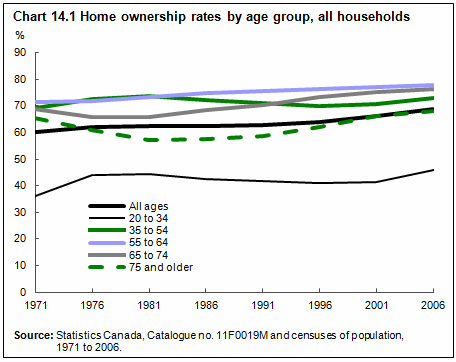Families, households and housing
Archived Content
Information identified as archived is provided for reference, research or recordkeeping purposes. It is not subject to the Government of Canada Web Standards and has not been altered or updated since it was archived. Please "contact us" to request a format other than those available.
Related information
Buying a house remains a major long-term investment for most Canadians. In 2006, more than 2 out of 3 households owned their residence—the highest home ownership rate since 1971. Of the 12.4 million households in Canada, more than 8.5 million owned their home.
For generations, home ownership rates have risen with age. The pace slows after age 40 and levels off near retirement age. In the early years of retirement, home ownership rates become stable, then they start declining when a person reaches their late 70s.
From 1971 to 2006, the level at which home ownership plateaued rose steadily for all birth cohorts. The peak of ownership increased from 73% for those born in the early 1910s to 78% for those born during the Second World War. In 2006, more than 75% of households owned their homes by the age of 65.
Ownership rates have declined among lowest-income earners
Home ownership rates vary with income level. Over the last 35 years, home ownership rates have declined among Canada's lowest-income group, whereas the rate has increased among higher-income groups.
The largest differences in home ownership rates associated with income are found among younger adults (aged 20 to 34). In 2006, among younger adults, more than 75% of highest-income households (average family income of $87,970) owned their homes, compared with less than 20% of lowest-income households (average family income of $10,340). Younger adults with high incomes had home ownership rates similar to people 10 to 20 years older with lower incomes.
The gap in home ownership rates across income levels has been widening. Among younger adults (aged 20 to 34) and adults in their prime working years (aged 35 to 54), the gap in home ownership between the top and bottom income groups widened from 1971 to 2006, particularly after the 1980s. Among Canadians in the older age group, the widening of the gap occurred primarily during the 1970s.
Conjugal relationships and home ownership
Being in a conjugal relationship and having children are each associated with higher home ownership rates. In the period from 1971 to 2006, couples with children had the highest home ownership rates at every income level. Lone parents also had much higher home ownership rates than couples without children at every income level, except for lone parents in the lowest 20% of income earners. Younger female lone parents were concentrated mostly at the bottom income level and their overall rate of home ownership was low.
Among younger adults, the presence of children is associated with a higher level of home ownership than is a conjugal relationship alone. But in the prime-working age and pre-retirement age groups, a conjugal relationship is more important than the presence of children in influencing ownership.
Among Canadians born between 1976 and 1980, just 15% of household maintainers aged 20 to 24 owned a home in 2006, whereas 62% of men and 56% of women in this age group lived in homes owned by others—in most cases, owned by their parents.
The tendency of adult children to remain living with their parents has risen over the last three decades. While 8% of adults aged 25 to 34 had not left their parents' homes in 1981, this rate increased continuously thereafter to reach 18% in 2006. Since men tend to form conjugal relationships later than women, they are likely to remain in their parents' home a year or two longer than women do.
Presence of children and home ownership
Younger families with children are most likely to own a home, especially younger families with the highest incomes. In 2006, 94% of couples aged 20 to 34 who were in the top income groups and who had children owned their own home. That is an increase from 1971, when 65% of such couples owned their home.
Though it is still lower, the home ownership rate for unattached younger adults in the highest-income group rose more rapidly than the rate for families. From 1971 to 2006, it jumped more than fivefold from 13% to 60%.
High-income, unattached younger adults and adults in their prime working years each had a home ownership rate well above that of the lowest-income couples with children. In 1971, unattached individuals had a low home ownership rate regardless of their income level.
- Date modified:

